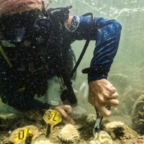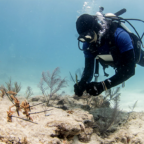
As we begin to piece together the damage from Hurricane Irma in Florida, scientists are pointing to an environmental factor that may have made the storm’s impact worse: the ongoing loss of coral on the state’s increasingly threatened barrier reef.
At 360 miles long, the Florida Reef Tract is the third-largest barrier reef in the world, stretching from the Florida Keys up to Martin County. But as The Washington Post reported just a few months ago, the reef is in big trouble — scientists estimate that less than 10 percent of it is covered with living coral, the result of a long history of damage that, most recently, includes warming waters and back-to-back bleaching events in recent years.
Now, scientists say these losses may have weakened the reef’s storm buffer.
Research demonstrates that “if you reduce coral reef health — if you go from that really rough coral reef with lots of live coral to a degraded coral reef with a relatively smooth surface — you have increased run-up in flooding,” said Curt Storlazzi, a research geologist with the U.S. Geological Survey.
In a follow-up email to The Post, he added that, based on recent observational and modeling studies, “the science indicates that had coral reefs been healthier across the Caribbean (including the Florida reef track), the resulting wave-driven run-up and coastal flooding of areas fronted by coral reefs would have been less than did occur (due to the current degraded nature of the coral reefs).”
And although the recent bleaching events along the Florida reef have drawn the most attention, new evidence suggests that this is part of a far broader — and longer — picture. A recent study in the journal Science Advances analyzed maps of the Florida Keys dating to the 18th century that noted the locations of coral reefs, and found that more than half the area formerly occupied by corals has been lost over the past 250 years. Most of these losses occurred near shore, suggesting that human influences and the expansion of European settlements most likely played a major role.
Many scientific authorities, including the National Oceanic and Atmospheric Administration and the U.N. Intergovernmental Panel on Climate Change, have pointed out that corals help reduce the risk of flooding during storms. The latter notes that reefs “contribute to protecting the shoreline from the destructive action of storm surges and cyclones.”
“The main effect of coral reefs on flood reduction, period, is because of wave breaking,” said Michael Beck, lead marine scientist at the Nature Conservancy. “It’s acting like a submerged breakwater offshore, breaking those waves, reducing and dissipating that wave energy offshore, so that then only tiny little amounts of wave energy come onshore.”
The effects are striking, research shows. One 2014 meta-analysis co-authored by Beck and Storlazzi along with other colleagues from Stanford, the U.S. Geological Survey and the University of Bologna in Italy, which compiled more than 250 individual studies, suggested that coral reefs may reduce the energy of incoming waves by up to 97 percent. Another meta-analysis from 2016 suggested that reefs may reduce the height of waves by 70 percent.
The effects of storm surge produced by hurricanes — that is, a temporary rising of the sea associated with large storms — can diminish the protective capacity of coral reefs by raising the water level, Storlazzi noted. But even in the case of storm surge, coral reefs can still have a significant buffering effect on wave action, he said.
Of course, it goes both ways — hurricanes can also damage reefs and weaken them.
Other natural wetland habitats, such as salt marshes and mangrove forests, also buffer shorelines and reduce the impact of flooding and erosion. But research comparing the influence of the different ecosystems suggests that coral reefs provide the greatest protection.
Yet all over the world, coastal communities may be facing greater risks of flooding and erosion, because of the widespread bleaching and dying of coral reefs. At least 900 miles of Australia’s Great Barrier Reef have experienced bleaching within the past two years, for instance, and the Florida Reef Tract has suffered widespread bleaching, disease and death as well. And under continued climate change, and increasingly warmer ocean waters, scientists think these kinds of bleaching events will only grow more frequent.
Bleaching and death can make the physical structures of corals weak and brittle, Beck pointed out. This makes the tops of corals more likely to be broken off by strong waves, reducing the height of coral reefs and rendering them less useful in breaking up subsequent waves. In turn, climate change is also expected to contribute to higher sea levels and higher waves in many areas, making it tougher even for healthy corals to break them up.
A 2015 paper in the journal Geophysical Research Letters, co-written by Storlazzi and other scientists from the U.S. Geological Survey and colleagues in the Netherlands, suggested that all of these factors — higher waves and greater degradation of coral reefs — will have a “significant negative impact on the ability of coral reefs to mitigate the effects of coastal hazards in the future.”
Other research, meanwhile, has found that the seafloor around key reefs — including those in Florida — is getting deeper as the reefs themselves decline. This is because dead coral turns into sand and feeds the seafloor, but when reefs stop growing as much, less sand is provided.
This, too, weakens the protection provided by coral reefs, U.S. Geological Survey researcher Kimberly Yates told The Post earlier this year. “Erosion of coral reefs and seafloor is happening much more and much faster than what was previously known or expected, enough so that it’s affecting those local sea level rises,” she said. “Enough so that it increases the risk to the coastlines from coastal hazards, storm waves, everyday persistent waves, tsunamis and those kinds of things.”
None of this is to say that the Florida Reef Tract, or any other coral reef, provides 100 percent protection against flooding or makes coastal communities “safe” in any way, Beck cautioned. But the reefs do significantly lessen the effect of waves, and their destruction is likely to have a noticeable effect.
“I think it’s incredibly important to recognize that these coral reefs are our first line of defense, and when we degrade them, we put ourselves at much greater risk,” he said.















Social Profiles